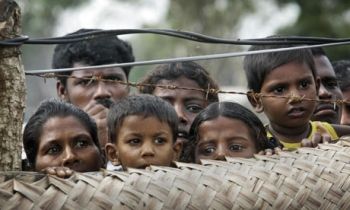
Publisher:
Bonnie King
CONTACT:
Newsroom@Salem-news.com
Advertising:
Adsales@Salem-news.com

~Truth~
~Justice~
~Peace~
TJP
Oct-31-2011 14:54

 TweetFollow @OregonNews
TweetFollow @OregonNews
The Forgotten Returnees
Salem-News.comUNHCR’s most recent statistics show that at the end of 2010 there are some 141,000 Sri Lankan refugees in 65 countries.
 Tamil refugees. Photo: guardian.co.uk |
(GENEVA) - A day in a village on the beautiful coast of northern Sri Lanka: a lady combing the hair of a small girl crouching at her feet. She leans over and whispers something to her husband who is sitting beside her holding on to two other children.
The scene could easily be captured on a picture postcard but if one looks closer the reality is grimmer. Many of the surrounding houses have been reduced to rubble or are heavily damaged: a reminder of Sri Lanka’s bloody decade long civil war.
Tractors loaded high with bags of clothes, household goods and bits of furniture indicate that people are returning and the hundreds of people lined up near the trucks filled with humanitarian aid show their desperate need for help.
Mariananthini, is the name of the woman, described in a report. She is among hundreds of thousands of people who were displaced internally during the final stages of Sri Lanka’s conflict. “My parents, my 11 siblings and their families all lived here. So when the sound of shelling drew closer in July 2008 we decided to leave together and find a safer place,” she said.
Five of Mariananthini’s siblings were killed, as they were trying to keep safe. Among those killed was Mariananthini’s 25 year old sister and husband, parents of 3 children. Now she and her husband have adopted the 3 orphaned children.
Mariananthini is among more than 220,000 persons who have left displacement camps in Sri Lanka’s north, to return to their places of origin under the Government-facilitated return process.
Although more than two thirds of the nearly 300,000 internally displaced people (IDPs) interned in the north at the end of the war have been sent home, most return to areas devoid of the most basic amenities, according to a 2011 report from the International Crisis Group (ICG).
Realities on the ground in the north and east which had been in rebel hands until the government forces´ final offensive are “ominous”, according to the ICG report which states that much of the aid promised has not arrived, and all is strictly controlled by the military. “Northern areas once ruled by the LTTE are now dominated by the military, which has taken over civil administration and controls all aspects of daily life. Killings, disappearances and violence against women continue to plague the north and east.”
The UN Refugee Agency (UNHCR) and its partners are supporting the return process, by providing the returnee families with basic household items like plastic mats, mosquito nets and jungle clearing tools as well as items of clothing and slippers to help them get back on their feet.
Thousands of Sir Lankans sought refugee in other countries. UNHCR’s most recent statistics show that at the end of 2010 there are some 141,000 Sri Lankan refugees in 65 countries, with the majority of close to 100,000 in Tamil Nadu, India.
As of end-September 2011, UNHCR has helped 1,500 refugees return home to the north and east this year. “The refugees, like the tens of thousands of internally displaced people who have returned home recently, face challenges in re-establishing themselves. Earning a living and getting decent shelter are two of the things returned refugees tell us are their greatest concerns,” says UNHCR’s representative in Sri Lanka, Michael Zwack.
 |
Like Mariananthini, many are unable to return directly to their homes which are either heavily damaged or destroyed. Some are actually not allowed to return home since the government has reportedly kept some IDPs’ areas of origin closed for return for reasons of national security, in other areas demining has not started.
The UN Resident and Humanitarian Coordinator Subinay Nandy visited the northern provinces in October: “So far, I have been struck, particularly in the recently resettled areas, by the great desire and determination of people to restart their lives and get back to some kind of normality. But, there remain gaps and a lack of facilities, livelihood opportunities and adequate capacities for a well-functioning civilian administration,” says Mr. Subinay.
Despite signs of progress, much remains to be done. In the village of Allankulam in the former rebel held territories in the north of the island, 62-year-old grandmother Selvanayagi Chellathurai now toils with five other women on a small vegetable plot to ease the financial burden of her extended family. She told IRIN that big development work had not directly benefited them. "We still spend hours just to get to the main town. There are electricity power lines, but we can't afford connections," she said. "At least before the war erupted, we had some kind of habitable house and a well for water. Now all that is gone."
Source: United Nations Regional Information Centre (UNRIC)
 |
 |
Articles for October 30, 2011 | Articles for October 31, 2011 | Articles for November 1, 2011
Quick Links
DINING
Willamette UniversityGoudy Commons Cafe
Dine on the Queen
Willamette Queen Sternwheeler
MUST SEE SALEM
Oregon Capitol ToursCapitol History Gateway
Willamette River Ride
Willamette Queen Sternwheeler
Historic Home Tours:
Deepwood Museum
The Bush House
Gaiety Hollow Garden
AUCTIONS - APPRAISALS
Auction Masters & AppraisalsCONSTRUCTION SERVICES
Roofing and ContractingSheridan, Ore.
ONLINE SHOPPING
Special Occasion DressesAdvertise with Salem-News
Contact:AdSales@Salem-News.com

googlec507860f6901db00.html



Terms of Service | Privacy Policy
All comments and messages are approved by people and self promotional links or unacceptable comments are denied.
[Return to Top]
©2025 Salem-News.com. All opinions expressed in this article are those of the author and do not necessarily reflect those of Salem-News.com.